The One Day International (ODI) format of cricket is one that has been around for a while now, but it is a format that has never stopped trying to innovate and reinvent itself to appeal to a wider section of fans. The format was seen as a bit of a joke when it was first experimented with in 1971, but since then it has become very legitimate in the eyes of the most people involved with the sport. Over time, rules have been developed that have allowed it to properly differentiate itself from the longer, test match version of the game.
Some of the most impactful rules that have been incorporated into the ODI format relate to fielding positions. Basically, there are rules that apply to ODI’s that dictate where fielding captains are allowed to place their fielders at different times during a match, and these rules make it harder for bowlers and their captains to set defensive fields. In simple terms, the rules take away the option of putting all of the fielders on the boundary makes it easier for batters to hit 4’s and 6’s, which is what the majority of spectators want to see!
As effective as the fielding restrictions are for enhancing the levels of entertainment we get from ODI’s, they can also be a great source of confusion for fans who haven’t been watching the sport that long! Fans may have questions such as – Where are fielders actually allowed to stand in ODI games? When are they allowed to stand there? Are there different rules for different times in a match? If you’re someone who is looking for the answers to those questions, as I was many years ago, then you’ll find them all in this post! Let’s get started…
So, what are the fielding restrictions in ODI cricket?
There are three ‘powerplay’ periods in ODI matches which govern where fielders can stand. In the first powerplay, two fielders are allowed to stand outside the 30-yard circle. In powerplay two, four fielders are allowed outside the circle. In the last powerplay, five fielders are allowed outside the circle.
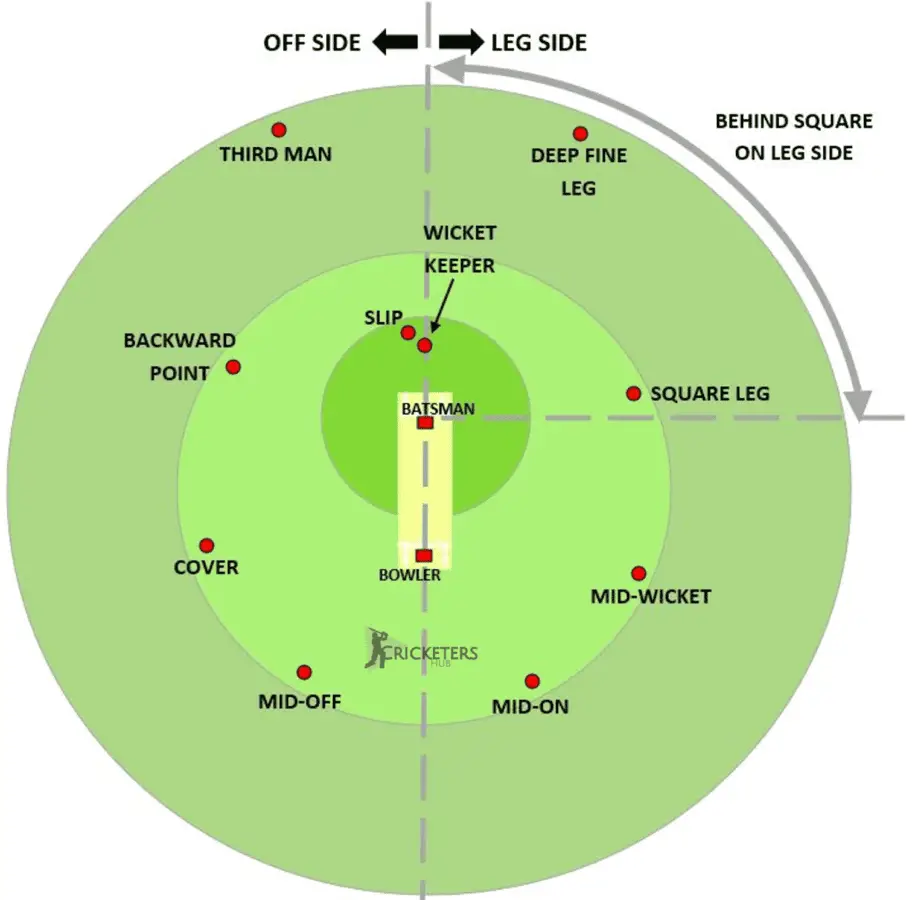
As well as the powerplay rules, I should also mention that a fielding side is only allowed to place a maximum of five fielders on the leg side at any point during the innings. The leg side is usually the most favoured scoring area for most attacking batters, therefore allowing the fielding team to place fielders all over this side of the pitch could severely reduce the number of boundaries that batters are able to hit. By limiting the number to five, fielding captains have to think a lot more deeply about where these fielders are going to be located and tailor their field placements to the individual strengths of different players.
Another fielding restriction in ODI cricket that not many people know about is that you are only allowed to place a maximum of two fielders behind square on the leg side of the field. Take a look at the diagram above if you’re unsure where that is! This restriction is put in place to stop bowlers bowling an endless barrage of short balls with 4 or 5 fielders behind square on the leg side that can catch the ball if the batter were to top edge it or miscue their shot. If there were no limit on the number of fielders that fielding captains could put in this position, then you’d probably see a lot more short balls being bowled – which would make things a lot more predictable and arguably detract from the enjoyment of the game. By only allowing two fielders in this zone, this means that a skilled batter can still work the ball into the gaps in this region if they are good enough to execute this type of shot.
Just in case you’re not sure when the different powerplays occur in ODI cricket, I thought I would give you a brief explanation! In a full ODI match where each side bats for 50 overs, each powerplay is taken at the following times:
- Powerplay 1 = First ten overs (60 balls) of the innings
- Powerplay 2 = Between the start of the 11th over and the end of the 40th over (180 balls)
- Powerplay 3 = The last ten overs (60 balls) of the innings
Powerplay 1
So, because there are only two fielders allowed outside the circle during the first powerplay, in this period of the game you’re likely to see a field that looks like the one shown in the diagram below. Also notice how there are only four fielders on the leg side, and only two fielders behind square on that same side of the field, satisfying those fielding restrictions. When batting against fields like this, the batters usually know that if they time the ball well and are able to place their shot, they will be able to pick up boundaries easily. Modern batters will also routinely hit the ball aerially over the heads of the close fielders. The first powerplay in an ODI is the best time to score runs, so all teams need strong opening batters that can play aggressively and exploit the fielding restrictions.
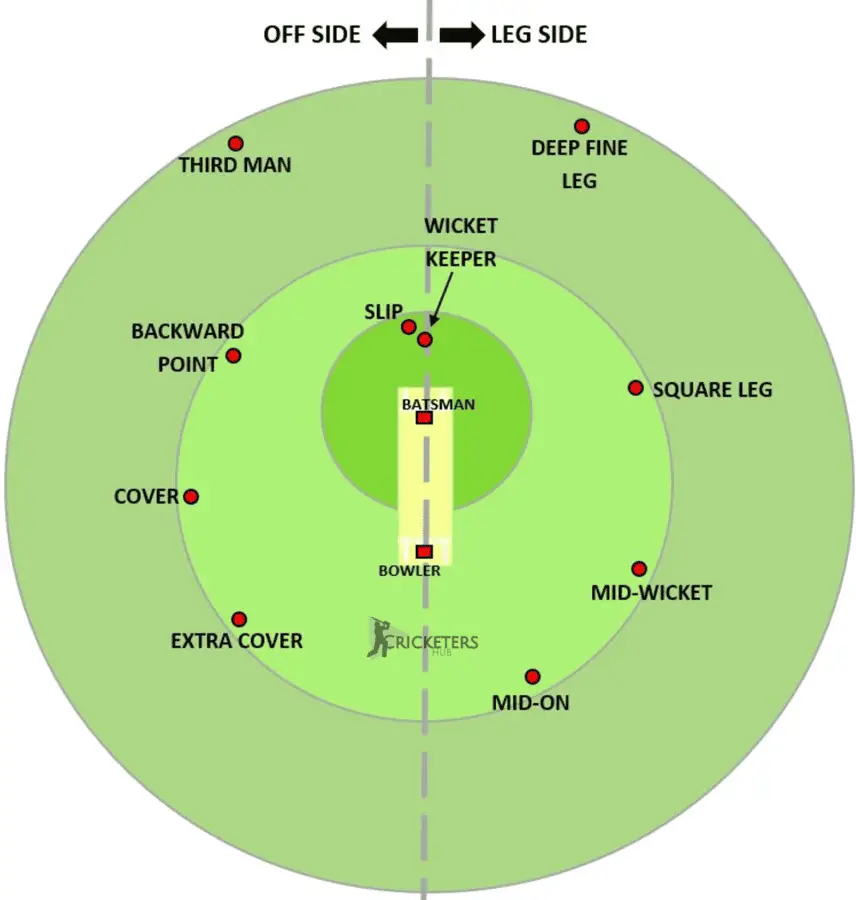
Powerplay 2
Powerplay 2 gives bowlers a lot more protection, as they are now allowed to place 4 fielders outside of the 30-yard circle, rather than the 2 that they had during the first powerplay. In powerplay 2, you’ll often see fielding captains using field placements like the ones in the diagram below. Because there are more fielders on the boundary during this period, batters will usually not be able to score as many boundaries. However, the most skilled players will exploit the gaps in the infield to pick up singles and twos, whilst still picking up the odd boundary to keep the run rate high. Bowling sides should be doing their best to take regular wickets during this period as it can really help tie a batting side down, and stops them launching an all out attack at the back end of the innings.
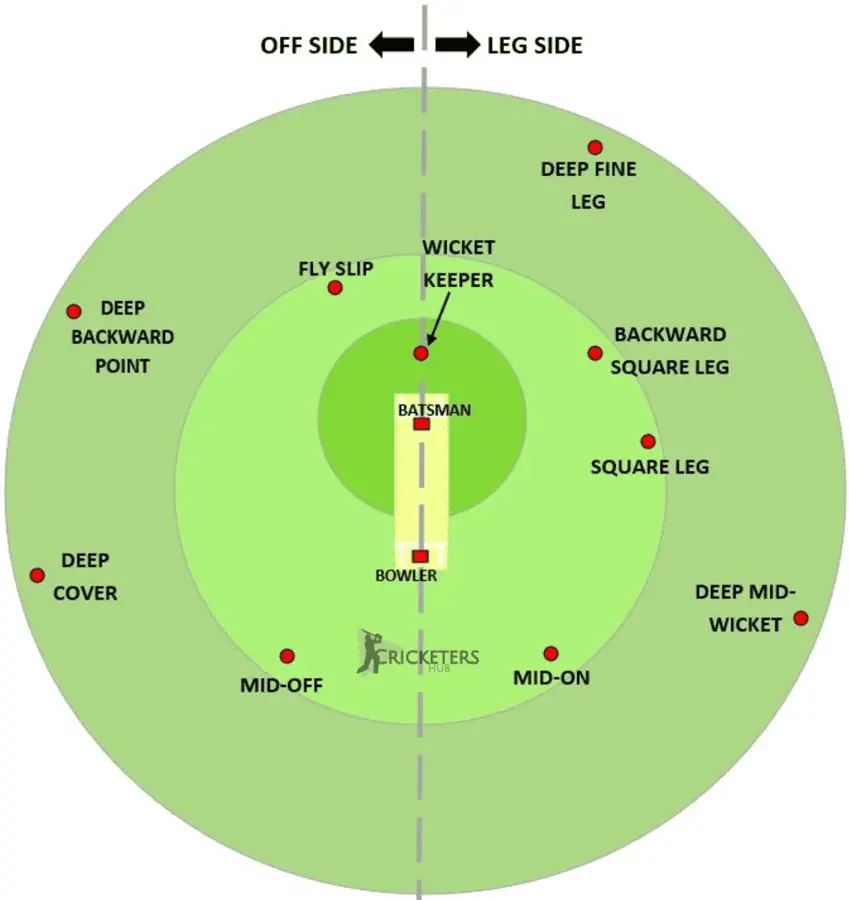
Powerplay 3
Powerplay 3 provides even more protection to the bowlers as a total of 5 fielders are allowed to stand outside the 30-yard circle. This extra protection is much needed, because this is usually the period of the game where batters are trying to hit every ball for a boundary to pick up as many runs as they can at the back end of an innings. During this period fielding captains will often set fields that look like the one in the diagram below, and will instruct their bowlers to use their variations and mix up their lengths in order to make the ball harder to hit powerfully. Against these fields some batters will back themselves to hit the ball over the heads of the fielders for 6, whilst others will move around the crease and play creative shots like the ramp to hit the ball in unorthodox areas.
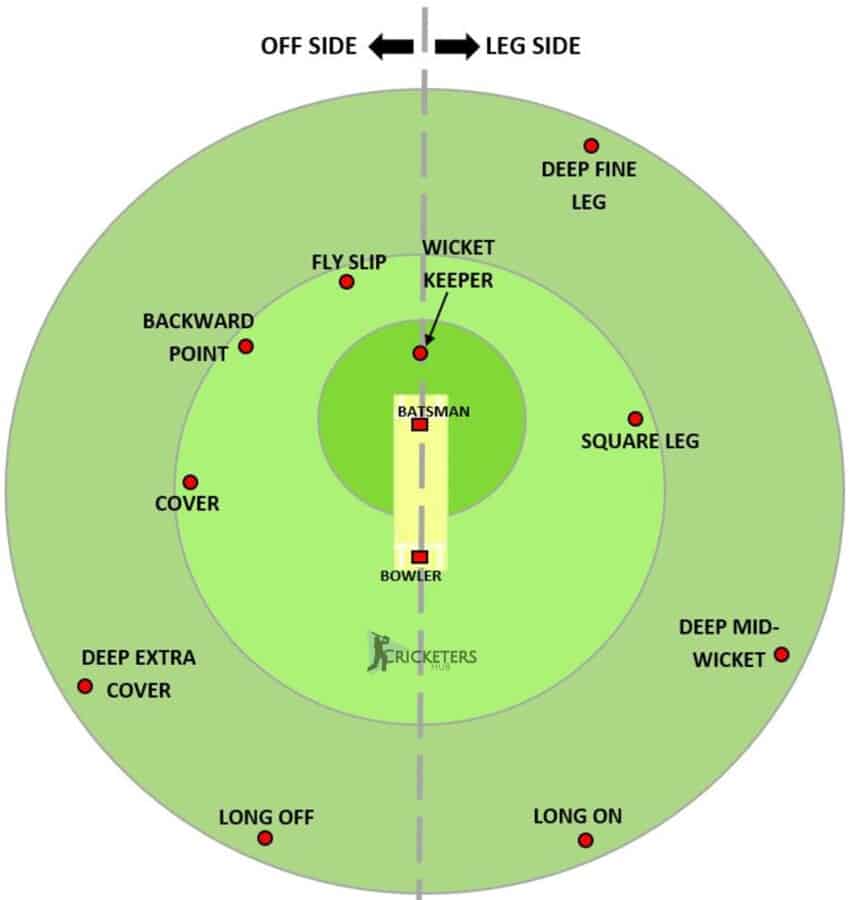
What Happens If Fielding Restrictions Are Ignored Or Broken?
The responsibility for checking the placement of fielders during a match lies with the on-field umpires as well as the TV replay umpires. To do this, they will closely monitor the exact positions of fielders as the bowler delivers the ball. If any fielding restrictions are violated at this point, one of the umpires will immediately call and signal a no ball. This will happen every time a fielding restriction is broken.
It’s important to note that the no ball is only called if the fielding restrictions are broken during the ball’s delivery. Before the ball is delivered, fielders have the flexibility to position themselves even in ways that might breach the rules. However, they must adjust and ensure compliance by the time the ball is bowled.
For instance, let’s consider a hypothetical scenario during the 1st over of an ODI match. As the bowler prepares to commence their run-up, the fielders may be positioned as shown in the diagram below. You can see in the diagram that there are 3 fielders outside the 30-yard circle, although only a maximum of two are allowed. The fielder that the yellow arrow is pointing to is actually intended to be inside the 30-yard circle at mid-off. This means that in order to avoid breaking the fielding restrictions, this fielder must quickly move into the correct position within the 30-yard circle before the ball is delivered. Failure to do so would result in the umpire calling and signalling a no ball.
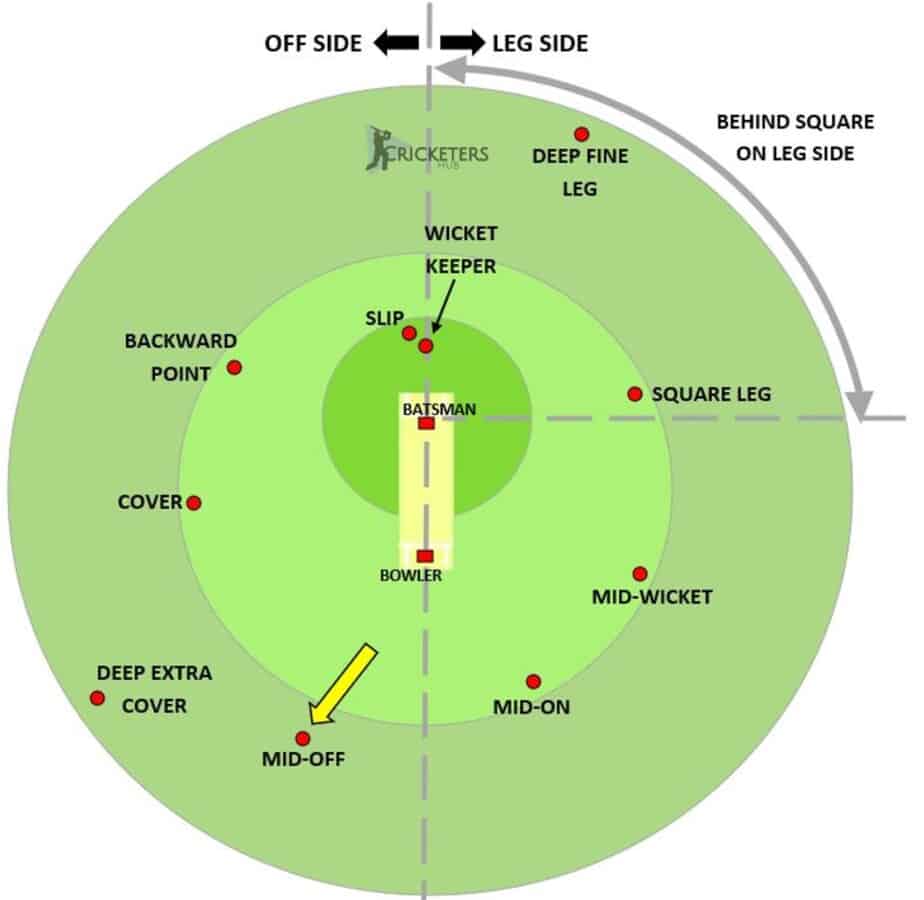
How Many Fielders Are Allowed In An ODI Match?
In ODI matches the fielding team will have 11 players on the pitch whilst the game is taking place. All of these players are allowed to field and catch the ball. However, one of these players will be required to bowl, and one will be undertaking the role of wicket keeper – which means their positions are relatively fixed. Therefore, when a delivery is being bowled, there are really only 9 fielders that will be patrolling the majority of the field and that will be changing their position from ball to ball.
How Many Fielders Are Allowed On The Off Side In An ODI Match?
If you’ve read through all of the sections above, you should know that there is a maximum of 5 fielders that are allowed to stand on the leg side of the field when the ball is bowled.
The same rule does not apply to the off side of the field. A fielding captain in an ODI match can place as many players on the off side of the field as they like. Theoretically, if the fielding captain wanted to place all of the players (apart from the wicket keeper and the bowler) on the off side of the pitch, they would be allowed to do so under the laws of the game.
However, just because the fielding captain is allowed to place all (or a majority) of the fielders on the off side, this does not necessarily mean it’s a good idea. Most batters in ODI cricket matches love to hit the ball through the leg side, and no matter where a bowler bowls, they will often find a way to hit the ball into that area. This is why I personally believe that it’s always a good idea to keep your field placements relatively balanced between the off side and the leg side. If a bowler were to bowl very wide of the off stump with all of their fielders on the off side, the batter could simply move across the crease to get themselves closer to the line of the ball before smacking it into the vacant leg side.
Personally, the maximum number of fielders that I’d consider putting on the off side of the field is 6. This would leave 3 fielders to cover the leg side. I think this is a good general rule, unless there are some very special circumstances at play such as bowling to a batter who is literally incapable of hitting the ball into the leg side or something similar!
Conclusion
I hope the information in this post has given you a good idea of the types of restrictions that fielding captains have to operate under during ODI matches. In the first powerplay it’s very tough to keep batters quiet due to the fact that only two fielders are allowed to patrol the boundary, but it becomes slightly easier to control the run rates as you move into the second and third powerplays. Fielding captains need to have a good knowledge of the fielding restriction rules, and they also need to be creative enough to tailor their field placements to the skills of each batter and the bowler that is operating!
I’ve written plenty of posts about field placings here on the site, so if you’re looking for more information I’d recommend checking some of those out. Also, keep an eye out for a new e-book I’m releasing soon which contains hundreds of field placement ideas that captains can use during different game scenarios!
